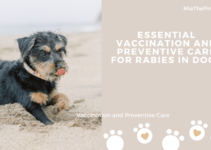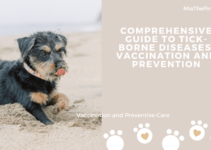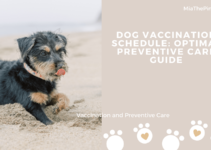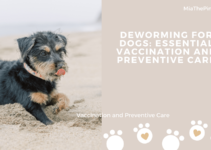The Importance of Spaying for Dogs
Spaying, also known as ovariohysterectomy, is a surgical procedure performed on female dogs to remove their reproductive organs. This procedure offers numerous benefits for both the dog and the owner. One of the primary reasons to spay your dog is to prevent unwanted pregnancies. By removing the ovaries and uterus, spaying eliminates the risk of accidental breeding, which can lead to overpopulation and the euthanasia of countless puppies.
Moreover, spaying your dog can significantly reduce the risk of certain health issues. Female dogs that are not spayed are prone to developing uterine infections, known as pyometra, which can be life-threatening. Additionally, spaying can prevent the occurrence of mammary tumors, which are often malignant in dogs. By spaying your dog, you are ensuring her long-term health and well-being.
Essential Vaccinations for Dogs
Vaccinations are a crucial aspect of preventive care for dogs. They protect our furry friends from various infectious diseases that can be debilitating or even fatal. Some of the essential vaccinations for dogs include:
- Rabies vaccine: This vaccine is required by law in many regions due to the severe consequences of rabies in both dogs and humans.
- Distemper vaccine: Distemper is a highly contagious viral disease that affects a dog’s respiratory, gastrointestinal, and nervous systems.
- Parvovirus vaccine: Parvovirus is a highly contagious viral infection that primarily affects the gastrointestinal tract, leading to severe vomiting and diarrhea.
- Hepatitis vaccine: Canine hepatitis is a viral disease that affects a dog’s liver, causing symptoms such as fever, vomiting, and jaundice.
It is crucial to consult with your veterinarian to determine the appropriate vaccination schedule for your dog, as it may vary based on factors such as age, lifestyle, and geographic location.
Preventive Care Measures for Spayed Dogs
After spaying your dog, it is essential to provide her with proper preventive care to ensure a healthy and happy life. Regular veterinary check-ups are crucial to monitor your dog’s overall health and detect any potential issues early on. Additionally, maintaining a balanced diet and providing regular exercise will help keep your spayed dog in optimal shape.
Furthermore, dental care is often overlooked but plays a significant role in a dog’s overall well-being. Regular teeth brushing and professional dental cleanings can prevent dental diseases and promote good oral hygiene.
Common Myths and Misconceptions about Spaying
There are several myths and misconceptions surrounding spaying that can mislead dog owners. One common myth is that spaying will cause dogs to become overweight. However, weight gain is primarily influenced by diet and exercise, not spaying itself. By providing a balanced diet and regular exercise, you can easily maintain your dog’s weight after spaying.
Another misconception is that spaying will change a dog’s personality. In reality, spaying only removes the reproductive organs and does not affect a dog’s basic personality traits. Any changes in behavior are more likely to be influenced by factors such as training, socialization, and individual temperament.
Spaying Procedure: What to Expect
The spaying procedure is typically performed by a veterinarian under general anesthesia. Before the surgery, your dog will undergo a thorough physical examination and blood tests to ensure she is healthy enough for the procedure.
During the surgery, the veterinarian will make a small incision in the abdomen to access the reproductive organs. The ovaries and uterus will then be carefully removed. The incision will be closed with sutures, which will either dissolve or require removal after a specified period.
It is essential to follow the veterinarian’s post-operative instructions, including providing pain medication, restricting physical activity, and monitoring the incision site for any signs of infection.
Post-Spaying Care Tips for Dog Owners
After the spaying procedure, your dog will require some special care to ensure a smooth recovery. Here are some post-spaying care tips:
- Provide a quiet and comfortable space for your dog to rest.
- Avoid bathing your dog for the first ten days after surgery.
- Prevent your dog from licking or chewing the incision site by using an Elizabethan collar.
- Administer any prescribed medications as instructed by the veterinarian.
- Monitor the incision site for any signs of redness, swelling, or discharge.
- Limit physical activity and prevent jumping or running until your dog has fully recovered.
By following these care tips, you can ensure a speedy and complication-free recovery for your beloved spayed dog.
FAQs
1. Why is spaying important for dogs?
Spaying is important for dogs because it prevents unwanted pregnancies and helps control overpopulation. It also reduces the risk of health issues such as uterine infections and mammary tumors.
2. What are the essential vaccinations for dogs?
The essential vaccinations for dogs include the rabies vaccine, distemper vaccine, parvovirus vaccine, and hepatitis vaccine. These vaccines protect dogs from severe and potentially fatal infectious diseases.
3. What preventive care measures should be taken for spayed dogs?
After spaying, spayed dogs should receive regular veterinary check-ups, maintain a balanced diet, engage in regular exercise, and receive proper dental care to ensure their overall health and well-being.
4. What are some common myths and misconceptions about spaying?
Some common myths and misconceptions about spaying include the belief that it causes weight gain and changes a dog’s personality. However, weight gain is influenced by diet and exercise, and spaying only removes reproductive organs without affecting personality traits.
5. What should dog owners expect during the spaying procedure?
During the spaying procedure, the dog will undergo general anesthesia, and a small incision will be made in the abdomen to remove the reproductive organs. The incision will be closed with sutures, and post-operative care instructions should be followed for a smooth recovery.




